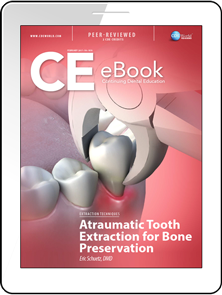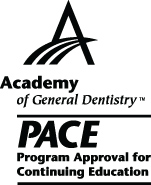CDEWorld > eBooks > Atraumatic Tooth Extraction for Bone Preservation


ADA CERP is a service of the American Dental Association to assist dental professionals in identifying quality providers of continuing dental education. ADA CERP does not approve or endorse individual courses or instructors, nor does it imply acceptance of credit house by boards of dentistry. Concerns or complaints about a CE provider may be directed to the provider or to ADA CERP at www.ada.org/cerp/

Approved PACE Program Provider. FAGD/MAGD credit. Approval does not imply acceptance by a state or provincial board of dentistry, or AGD endorsement. 1/1/2023 to 12/31/2028. ID # 209722.
eBook
Released: Thursday, March 23, 2017
Expires: Saturday, February 29, 2020
Atraumatic Tooth Extraction for Bone Preservation
By Eric Schuetz, DMD
Commercial Supporter: Directa AB
When teeth that need to be extracted are damaged, otherwise nonrestorable, or healthy and nonsymptomatic, preserving the natural bony architecture is paramount. Ample good-quality, natural bone remains the most significant factor contributing to long-term implant treatment functionality, esthetics, and overall success. Conventional extraction techniques using inefficient instruments can be traumatic and lead to bone loss, ridge collapse, and a more difficult site for future implant placement and stability. Atraumatically extracting teeth avoids injury to the bone, preserves the socket, and is increasingly important to ensure long-term implant function and esthetics.
LEARNING OBJECTIVES:
-
Identify available instruments for atraumatic tooth extraction techniques.
-
Describe the characteristics of atraumatic tooth extraction techniques and explain the significance of these techniques for dental implant success.
-
Discuss the differences between atraumatic and traumatic tooth extraction techniques.
About the Author
Eric Schuetz, DMD
Private Practice, North Miami Beach, Florida


